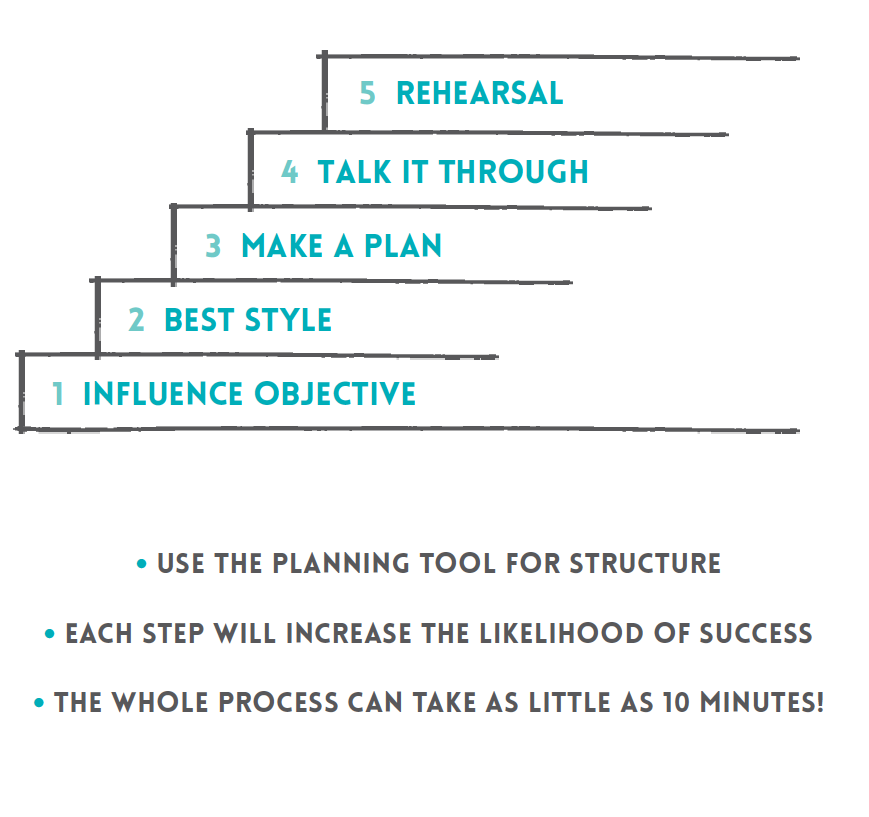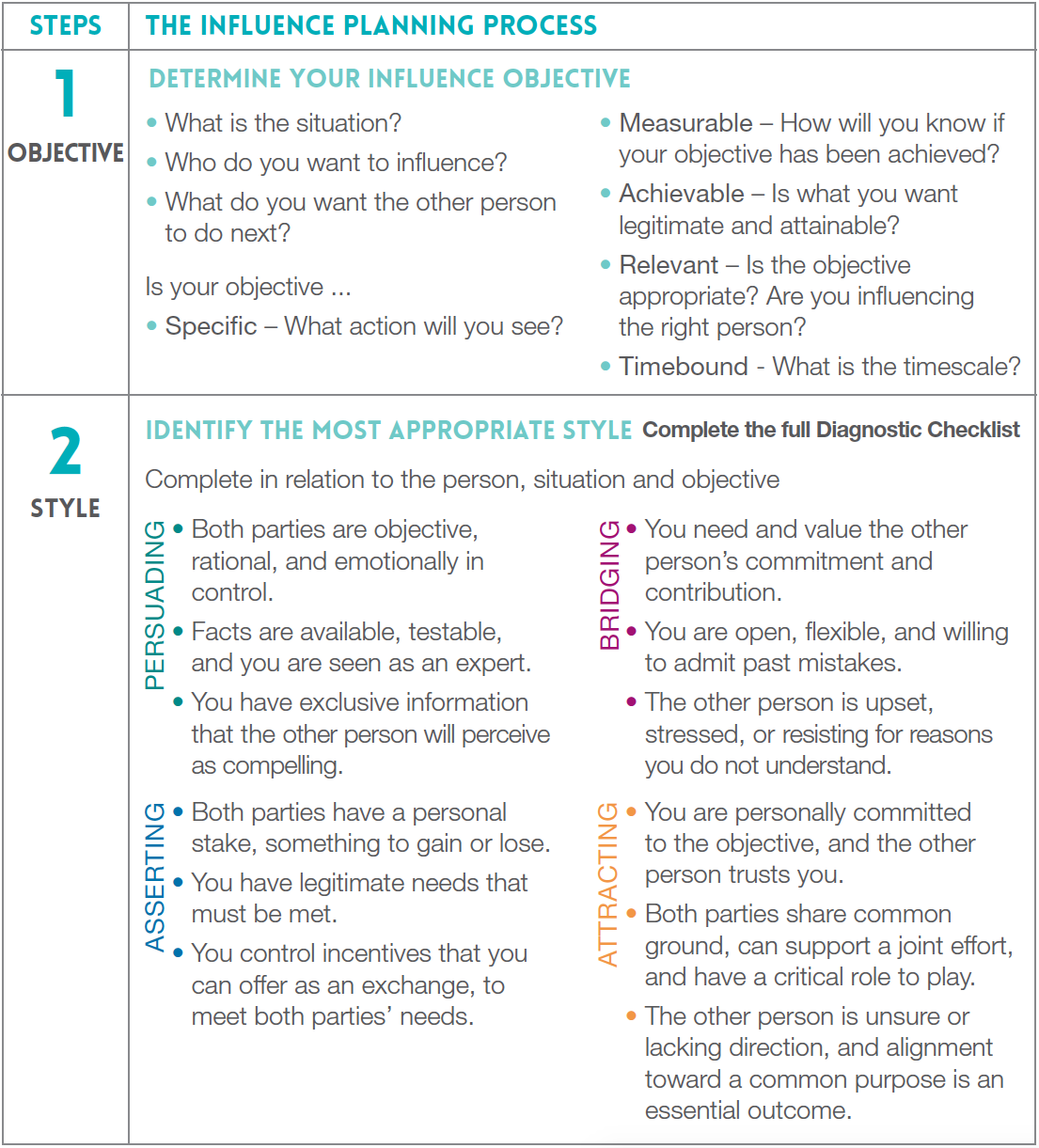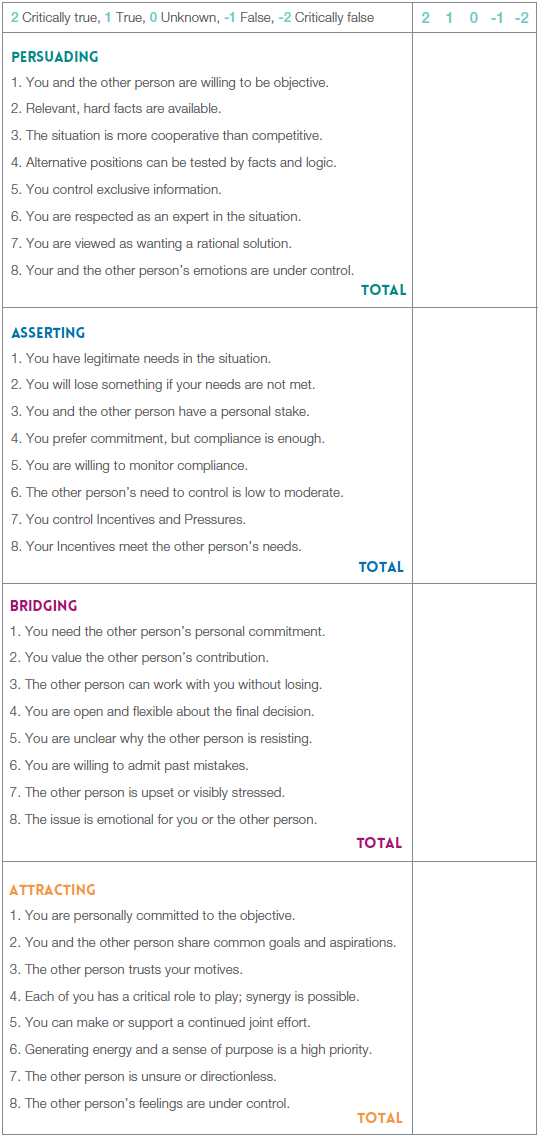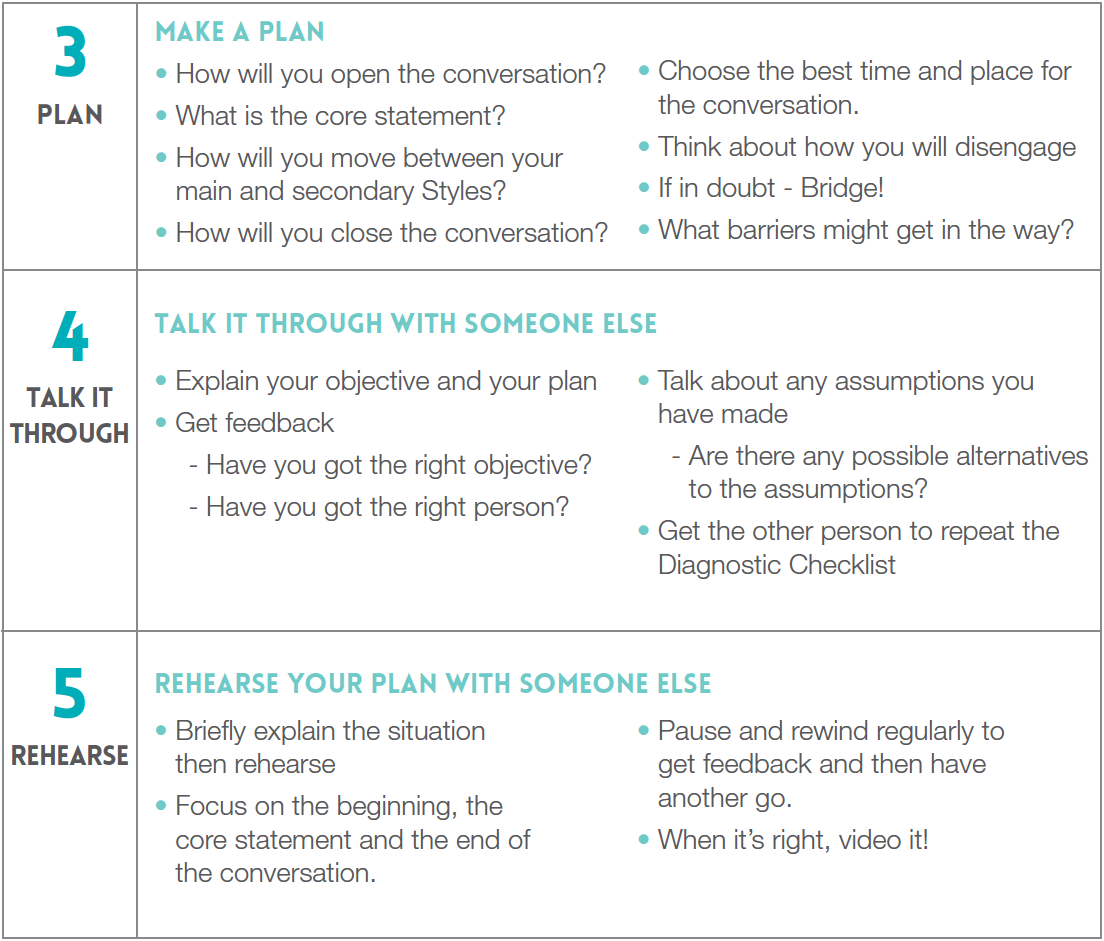Preparing for upcoming Influence Situations
Why Plan
Manage risk and develop a contingency plan
Overcome instinctive reactions – set specific objectives and the most effective Style


The full Diagnostic Checklist


Additional Guidance
More thoughts on Planning
Planning opens up a wide range of influence opportunities. Before the programme, you probably saw few situations as requiring influence. Other situations may have seemed too dangerous or complicated for you to address. Now you are likely to see more opportunities, whose risk or difficulty you can handle. As you become more experienced, you will be able to see how to apply the planning process to a variety of situations.
Planning supports the decision to use (or not use) positive influence. Experienced influencers see many, if not most, situations as requiring influence. However, strategies such as technical problem-solving, team building, and bureaucratic process are also valid options. Many of these strategies can be used in combination with positive influence skills. Planning will help you decide whether positive influence is the best or only strategy to use when faced with a particular problem.
Planning helps to overcome instinctive “gut reactions” to situations. Some influencers react to situations impulsively. Perhaps they neglect to set Influence Objectives. Or they use familiar, less stressful, or more comfortable Styles instead of Styles that fit the situation. Planning will help you set specific objectives and choose effective Styles to accomplish them.
Planning supports Influence Style flexibility. During the planning process, you will conduct a thoughtful review of each Style option. You will learn that different Styles will help you achieve different objectives in different situations. This awareness will motivate you to develop a wide range of influence skills to meet the needs of any situation.
Planning helps you identify Influence Style alternatives. Some situations may require intervention, facilitation, or counselling (Bridging). Other situations may require visionary leadership (Attracting), clear directions and feedback (Asserting), or logical analysis (Persuading). Planning will help you determine the best influence approach for each situation.
Your Influence Situation
Objective
Apply the Five Step Planning Process to a Influence Situation of your own.
Instructions
Choose a Influence Situation to work on during the remainder of the programme. This should be:
- Real. Choose a task-oriented situation or problem that is truly important and has a high priority for you.
- Challenging. The situation should require full concentration of your personal influence skills to achieve resolution.
- Feasible. The situation should provide you with the possibility of successfully influencing the target. It should not be hopeless, impossible, or beyond repair.
- Immediate. You are in a position to take action soon enough to fully achieve the benefits of planning.
- Disclosable. You should feel comfortable discussing the situation with two or three other people in the program.
- Understandable. The situation should not be too technically complex or difficult for others to understand. »Involves one target. You should be able to focus on a single person, or an opinion leader or key decision maker.
Step 1: Determine your Influence Objective
Step 2: Identify the most appropriate Style
Step 3: Make a Plan
Step 4: Talk it through with someone else
Step 5: Rehearse your plan with someone else
Determine your Influence Objective
Instructions
A. Define the situation. What is the problem you are facing? What are its symptoms and causes?
B. Identify and describe the person who is your influence target. Who can best help you achieve your Influence Objective in this situation?
C. Describe desired results. What outcomes would you prefer to occur in the situation that are not already occurring or are at risk? Allow yourself to be optimistic: focus on the positive results you might achieve and less on what is wrong with the situation or the people involved.
D. Construct clear Influence Objectives from your desired results. What is the specific next step that you want your influence target to take? In some influence situations, you may have more than one objective (for example, a short-term and a long-term objective). Make sure each objective is:
- Specific. Know what you want. Avoid generalisations, but do not be so specific that you reduce your flexibility. Determine what you want the target to do as a result of your influence attempt.
- Measurable. How will you know that you have achieved your Influence Objective? How will you know when to Disengage? Short-term objectives are usually easier to measure and implement than long-term objectives.
- Achievable. Does your objective fit current needs? Is what you want legitimate and attainable? Is it possible for the influence target to take an action that will help you to reach your objective?
- Relevant. Is the specific influence target capable of helping you achieve your Influence Objective in this situation? Consider whether you need to influence someone else first before you approach your primary target. In other cases, your choice of target will be appropriate but your objective may be too ambitious or risky. Consider whether a series of shorter-term objectives might be more appropriate.
E. Prioritise. If you have more than one Influence Objective in this situation, decide which objective is most important. There is usually one objective that is primary.
F. Finally, allow a quick review of your work in Step 1. Will your Influence Objectives serve as clear, firm criteria for measuring your progress in the situation, defining success, and implementing agreement? If in doubt, rework your objectives to include more detail before proceeding further with your planning.
Identify the most appropriate Style
Instructions
The Best Style for the Objective (BSO) is the style that will give you the highest probability of success given the nature of the situation and your objectives. For each influence style, choose which factors are critically true, true, false, critically false or unclear. Critically true factors are those that are both true and CRITICAL to the situation. Critically false factors are those that are both false and CRITICAL to the situation. If you are unsure whether a factor is true or false, choose unclear.
Rate each key factor on the Checklist in your journal based on your analysis of the specific situation and on the Influence Objective you have selected
Add up the total ratings for each Style.
Summarise unknowns as well as any other issues raised by your analysis.
Choose the Best Style for the Objective (BSO) for your primary Influence Objective. Force-rank the Styles, based on your rating totals and your consideration of “unknowns.” If you encounter difficulty selecting a BSO, follow the troubleshooting guidelines below and make any necessary adjustments to your analysis.
If you have an important secondary Influence Objective, repeat your analysis to obtain a BSO for this objective. Conduct the analysis independently of your primary objective’s BSO. They do not have to match.
Make a Plan
Instructions
Step 3 involves contingency planning (or “risk management”). Therefore, Step 3 asks you to develop a realistic plan for implementing the Best Style for the Objective and asks you to actually design a potential flow for the conversation.
Write a Core Style Statement for your Influence Objective. Remember that the Core Style Statement is your influence message stated in the language of the Influence Style. In this case, your Core Style Statement should be based on your Best Style for the Objective.
Develop an Influence Style Action Plan. Use your preparation of a Core Style Statement and contingency planning to build a “Style sequence.” What happens at what time? In what order? How will you begin? How will you introduce your Core Style Statement? How will you end? Consider:
- A Support Style. What other Influence Style might help you maximise your Best Style for the Objective? What Style came in “second” when you completed the Diagnostic Checklist?
- A Backup Style. Despite your best efforts, if your Best Style and your Support Style are ineffective, what Influence Style might serve as an alternative, or a “last resort”—or your “comfort Style”?
Prepare a contingency outline for your Best Style by thinking through at various points how to Disengage. Influence is a “two-way street”—the influence target is likely to be trying to influence you. Also, the Best Style analysis in Step 2 makes no assumption about your actual skill level for any of the Styles. Based on the Diagnostic Checklist results in Step 2, what options would you consider if, despite your best efforts, your influence attempt does not go as planned? What negative critical factors or unknowns might you need to prepare for?
- Skill gaps, value conflicts, or blocks. Are there any current barriers that might interfere with your successful performance of the Best Style for this Objective? If so, what are they? What might the other person do that could trigger any of these performance problems?
- Handling tension and stress. If you anticipate resistance, negative reactions, or strong emotions from your influence target, how will they surface? How will you handle them? What Disengaging actions might you plan to take?
- Logistics. Sometimes the setting or location of an influence attempt can affect your ability to influence effectively. Consider where and when you will conduct this influence attempt. Are there any aspects of the setting you could determine in advance that might increase your effectiveness?
Talk it through with someone else
Introduction
Step 4 of the Five-Step Planning Process is to consult with others. The purpose of the consultation is to review, evaluate, and troubleshoot your Action Plan with an objective third party. A consultant can give you fresh insights on the problem itself and help you refine or improve your influence approach. Choose a consultant who is knowledgeable about the target, familiar with the situation, and/or who understands the positive influence process. During your consultation, take notes on the Planning Form on the next page.
Instructions
Brief your consultant on the situation, using your Step 1 Planning Form. You have collected considerable data on the situation. Start at the beginning and review the information that you have developed to define your Influence Objectives.
Assess your Influence Objectives. Do your Influence Objectives make sense to your consultant? Can they be more Specific, Measurable, Achievable, or Relevant? Should you expand them?
Ask your consultant to fill out a Diagnostic Checklist (Step 2) as you describe your situation. Compare your Diagnostic Checklists. If there are differences, discuss them. Do not be defensive; remember, your consultant is trying to help you by describing how the situation looks from the receiving end of the problem.
Get feedback on your Action Plan (Step 3). Consider your consultant’s changes or suggestions. Be both critical and receptive. Balance your response: compare your knowledge of the situation to your consultant’s interpretation of the events and conditions you have described.
Limit your discussion to influence-related issues. Throughout the consultation, defer getting advice on other matters to a later time. Focus on your Influence Objectives and the work you have done for Steps 1 through 3 of the Planning Process.
Consider all changes that you make to your Action Plan as tentative. In Step 5 you will have a chance to test your conclusions against those of your consultant. Plan to set aside time in your rehearsal to try alternatives
Rehearse your plan with someone else
Rehearsal is a familiar preparation step for any important event. It might involve talking to yourself, mentally trying out words and phrases that you think will have the most impact. It might involve visualising a successful encounter or even practising in front of a mirror.In Step 5, you will bring these actions out into the open. You will ask another person to play the role of your influence target. Other participants will act as coaches. You will discover weak points, redesign approaches, and test their effectiveness. As you build and strengthen your influence approach, you will attain a level of confidence that will help you apply your Action Plan in real life.
Instructions
- Start the recorder.
- Brief your rehearsal partners, select one person to play your target, and set the scene. Describe what led up to the meeting that is about to take place. Tell the target how to act.
- Begin the dialogue with a warm-up. Say what you really want to say as directly as possible without regard to Style. Get quick feedback from your target or coaches about the clarity of your Influence Objective.
- Begin again. Practise your Action Plan. State your BSO Core Style Statement. Test alternative approaches. Coach the target to play the role realistically. Make the rehearsal as close as possible to reality. Do not lose sight of what you really want to say. Coaches should use the “Tally Sheet: Rehearsal” provided to record reactions and organise their feedback.
- Stop the dialogue whenever the target or coaches feel you have gone off track. Get feedback and coaching. Begin the dialogue where you left off, back up a few paces, or try a new approach.
- When you have found a successful approach, repeat it. Repetition will increase your confidence and make your performance less stressful during the action influence situation.
- Record all discussion, rehearsal, and feedback, but limit playback to crucial points. You can use the tape after the rehearsal as a refresher and for additional study and practice.
- Before moving to the next person in your group, please complete the CIS Dress Rehearsal questions.
Sequence Summary
- Record your entire session, including feedback. Reviewing could help you later.
- Brief your partners; select a person to play your target; set the scene.
- Begin your first attempt with your Core Style Statement. Work on making it as comfortable and natural as possible.
- Now, rehearse. Stop the dialogue as necessary to get feedback and coaching.
- When you have found a successful approach, repeat it.
Suggestions for Carrying Out the Roles
Influencer
- Select an actor who you feel can best play the influence target.
- Visualise the actor as your influence target.
- Use your real-life influence target’s name.
- Act out your plan. Do not talk about it any more than necessary to get started.
- Work in short bursts. If you go off plan, back up and start over.
- Interrupt the dialogue to coach the actor.
- Review your Action Plan and make appropriate adjustments based on the feedback you receive.
- Repeat the interaction several times. You will learn more from repetition.
- Do not stop when you achieve success. Repeat it!
Target/Actor
- Let yourself be influenced if the influencer does a good job. Do not overact. Play the role realistically.
- Ask the influencer to coach you on how to stay in the role.
- Give frequent feedback to the influencer. Comment on “impact” issues.
Coach
- Stop the dialogue if the influencer is not making progress or veers off the plan.
- When necessary, ask the influencer to restate the Influence Objective and the Core Style Statement.
- Critique the influencer’s performance of the Core Style Statement and the ongoing use of the Best Style.
- Give focused feedback on influencer’s impact.
- Interrupt even if the influencer is making progress toward the Influence Objective.
- Use a Tally Sheet to record the Styles and Behaviours you observe.
- Give the best feedback you can on the influencer’s effectiveness.
